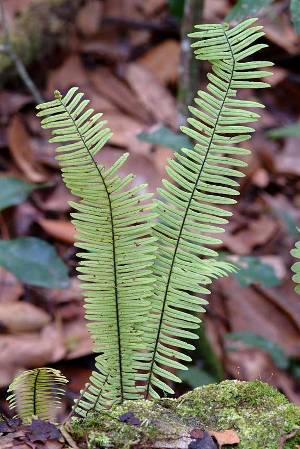Plants of South Florida · Plants by Conservation Area · Plants by County · Plants by Habitat Quick Search · Advanced Search |
||
|
|
||
 |
Pecluma dispersa (A.M.%20Evans)%20M.G.Price Widespread%20polypody |
|
|
South Florida Status: Historical. Last known plants removed from the wild in 1980. Taxonomy: Pteridophyte; Polypodiaceae. Habit: Perennial epiphytic, lithophytic, or terrestrial herb. Distribution: Native to peninsular Florida, the West Indies, Mexico, Central America, and South America. Wunderlin & Hansen (2000) reports it as occasional in Florida in Alachua County and in the central and southern peninsula. South Florida Distribution: Martin County and the Monroe County Keys. South Florida Habitats: Rockland and mesic hammocks. Protection Status: Listed as endangered by FDACS and as imperiled by FNAI. Aids to Identification: Chafin (2000) has illustrations and color photos; Nelson (2000) has a color photo; the IRC Website has a color photo. References: Evans, 1968; Lakela & Long, 1976; Long & Lakela, 1976; Correll & Correll, 1982; Flora of North America Editorial Committee, 1993; Wunderlin, 1998; Chafin, 2000; Coile, 2000; Liogier & Martorell, 2000; Nelson, 2000; Wunderlin & Hansen, 2000. Synonyms: Polypodium dispersum A.M. Evans. Historical Context: Allan H. Curtiss first collected widespread polypody in 1897 in “dry woods” at Sewell’s point in Martin County (5861, FLAS, NY). Clifton E. Nauman and Bruce E. Tatje discovered another Martin County station in 1978 in or near what is now Rocky Point Hammock, a Martin County conservation area (524, USF). Recent surveys of Rocky Point Hammock by Bradley and Woodmansee failed to locate any plants, but this site needs additional surveys. John Kunkel Small and Charles A. Mosier first collected widespread polypody in Monroe County in 1915 on Pumpkin Key, a small island off the coast of Key Largo in Biscayne Bay (5686, FLAS, NY). Small vouchered this station again in 1920 (9501, NY), and several observations were made of the Pumpkin Key plants over many years (Avery’s Notes, January 1969, 24 February 1970). Mark C. McMahon made the last voucher of this population in 1977 (2001, FAU). Roger L. Hammer removed the last plants on Pumpkin Key in 1980 prior to the development of the island (Avery’s Notes, 5 December 1980). These plants were given to John Popenoe at Fairchild Tropical Garden, but apparently they have since perished (R.L. Hammer, personal communication, 7 February 2001). The only other station to be collected in South Florida was on Key Largo in Monroe County. John Kunkel Small vouchered the Key Largo station once in 1916 (7294, US; 7299, NY). No subsequent collections or observations of the Key Largo plants have been made. Recommendations: · Survey Pumpkin Key and Rocky Point Hammock. · If plants are found, map and monitor known populations. · Consider reintroduction to Key Largo at Crocodile Lake National Wildlife Refuge, Dagny Johnson Key Largo Hammocks Botanical State Park, Dove Creek Hammocks, and John Pennekamp Coral Reef State Park. · Acquire Pumpkin Key. |
||



